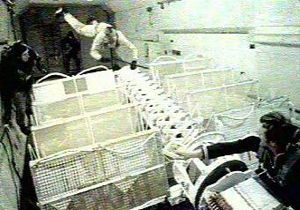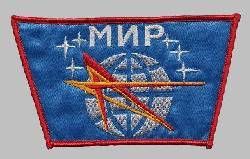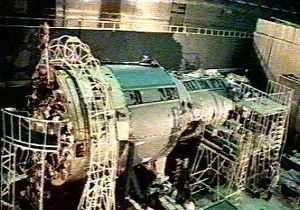
Home - Search - Browse - Alphabetic Index: 0- 1- 2- 3- 4- 5- 6- 7- 8- 9
A- B- C- D- E- F- G- H- I- J- K- L- M- N- O- P- Q- R- S- T- U- V- W- X- Y- Z
Soyuz TM-2
 Mir solar array Test of deployment of Mir solar array on zero-G aircraft. Credit: RKK Energia |
AKA: Mir EO-2;Soyuz TM-2 (Laveykin);Taimyr (Taimyr - Russian peninsula). Launched: 1987-02-05. Returned: 1987-07-30. Number crew: 1 . Duration: 174.14 days.
Mir Expedition EO-02 docked with Mir 7 February 1987 with the crew of Yuri Romanenko and Aleksander Laveykin. Laveykin, returned early with the crew of Soyuz TM-3 to Earth, leaving Romanenko to continue on a record-duration mission as part of the EO-3 crew with Aleksandrov. Soyuz TM-1 undocked from Mir 8:34 GMT 29 July. The orbital module was jettisoned prior to retrofire and left in a 308 X 356 km orbit. The returning crew was recovered on July 30, 1987 01:54 GMT.
Narrative (adapted from D S F Portree's Mir Hardware Heritage, NASA RP-1357, 1995)
The Mir space station, which had been launched prematurely on the orders of the Soviet leadership, remained vacant after the departure of the Soyuz T-15 crew on July 16, 1986. In September 1986 the Altair/SR relay satellite Cosmos 1700 ceased operating and drifted off its geosynchronous orbit position. This reduced the station to communications via earth ground stations. The Progress 27 freighter docked with the station on January 18 and boosted Mir's mean altitude by 16 km to 345 km on January 26 in preparation for the launch of the EO-2 second main expedition. At this point only one of Mir's computers was functional.
Soyuz TM-2 docked with Mir on February 7, 1987. Following reactivation of the station and unloading of Progress 27, the freighter departed the station on February 23. It was followed by Progress 28 from March 5-26, 1987, which then departed to clear the aft port for the large Kvant space station module.
Kvant consisted of the space station module (11 tons) and a unique FGB-based vehicle called the Functional Service Module (FSM) (9.6 tons) which acted as a space tug. The FSM carried out major maneuvers on April 2 and April 5. On April 5 its Igla approach system began homing on Mir's aft port. The EO-2 crew retreated to Soyuz TM-2 so that they could escape in the event the module got out of control. About 200 m out, the Igla system lost its lock on Mir's aft port Igla antenna. The cosmonauts watched from within Soyuz TM-2 as the Kvant/ FSM combination passed within 10 m of the station.
Kvant and its FSM drifted 400 km from Mir before being guided back for a second docking attempt. Soft-dock occurred early on April 9. Kvant's probe unit would not retract fully, preventing hard docking between Mir and Kvant. The Soviets left Kvant soft-docked while they considered a solution. Maneuvers were impossible during this period, because the probe of the Kvant/FSM combination would wobble loosely in Mir's aft port drogue unit, banging the docking collars together.
On April 11 Romanenko and Laveykin exited Mir to examine and, if possible, repair the problem with Kvant. They discovered a foreign object lodged in the docking unit, probably a trash bag they had left between Progress 28 and Mir's drogue. On command from the TsUP, Kvant extended its probe unit, permitting the cosmonauts to pull the object free and discard it into space. Kvant then successfully completed docking at a command from the ground. The EVA lasted 3 hr, 40 min. The Kvant FSM undocked from Kvant on April 12, freeing the module's aft port to fill in for the Mir aft port
The EO-2 crew entered Kvant on April 13 and began unloading equipment into the base block. Kvant added 40 m3 of pressurized volume to Mir, bringing the total to about 130 m3. On April 16 the pointing motors on Mir's two solar arrays were linked to sensors on Kvant. Kvant carried stowed solar arrays intended to be attached to a fixture on top of the small-diameter section of the base block.
Progress 29 arrived and remained docked to the aft docking port of Kvant from April 23-May 11, 1987. Beginning April 30, the EO-2 crew tested orienting the Mir complex using Kvant's gyrodynes. In part this was in preparation for pointing the new module's roughly 1000 kg of astrophysical instruments. During this period, propellant was pumped through Kvant to Mir's ODU for the first time. The Elektron system aboard Kvant, which produced oxygen by electrolysis of water, was readied on May 8.
The Soviets acknowledged that Mir was short on electricity. The situation became particularly difficult when melts lasting days were conducted using Korund 1-M. The EO-2 crew spent most of May conducting medical experiments and Earth resources photography, activities which required little electricity.
Progress 30 arrived and remained docked to Kvant's aft port from May 21-July 19, 1987. On June 12 the EO-2 crew exited Mir's multiport node for the first of two EVAs to install the solar array delivered by Kvant. There was insufficient room available in the multiport node for two spacesuited cosmonauts plus the main boom and first two sections of the new array, so Laveykin and Romanenko sealed the hatch between the Soyuz TM-2 docking module and orbital module and left the hatch between the orbital module and the multiport node open, creating an extended airlock. One cosmonaut worked outside while the other handed out needed parts. The main boom of the array was an extendible girder like the one assembled outside Salyut 7 by the Mir Principal Expedition 1/Salyut 7 Principal Expedition 6 crew (Kizim and Solovyov, 1986). The first EVA lasted less than 2 hr. The second EVA, on June 16, installed the remainder of the solar array, attached its electrical connections to the Mir power system, and extended it to its full 10.6-m length. The new, 22-24 m3 array brought Mir's total capacity to 11.4 kW. The EVA lasted 3 hr, 15 min.
The Roentgen Observatory on Kvant was uniquely placed to study Supernova 1987a in the Large Magellanic Cloud. The cosmonauts examined the exploding star during 115 sessions between June and September.
Soyuz TM-3 arrived at the station and docked to the aft Kvant port. It would remained docked to the station from July 22-December 29, 1987. The Visiting Expedition observed Syria and conducted materials processing experiments. Syrian guest cosmonaut Mohammed Faris and Soviet cosmonaut Alexandr Viktorenko returned to Earth in Soyuz TM-2 with Alexandr Laveykin, who was diagnosed by ground-based doctors as having minor heart problems. He was replaced by Alexandr Alexandrov, who had arrived aboard Soyuz TM-3.
More at: Soyuz TM-2.
Family: Manned spaceflight. People: Laveykin. Spacecraft: Soyuz TM.
 | Mir EO-2 Credit: www.spacefacts.de |
 | Mir in assembly hall Credit: RKK Energia |
1986 November - .
- Kvant module delivered to Baikonur - . Nation: Russia. Flight: Soyuz TM-2. Spacecraft Bus: 37K. Spacecraft: Kvant. Kvant was originally to be launched in late 1986 but problems with its scientific payload resulted in it spending 14 months (versus 5 planned!) at the spacecraft integration hall at Korolev..
1987 January 16 - . 06:06 GMT - . Launch Site: Baikonur. Launch Complex: Baikonur LC1. LV Family: R-7. Launch Vehicle: Soyuz-U2.
- Progress 27 - .
Payload: Progress s/n 135. Mass: 7,230 kg (15,930 lb). Nation: Russia.
Agency: MOM.
Program: Mir.
Class: Manned.
Type: Manned logistics spacecraft. Flight: Soyuz TM-2,
Soyuz TM-2 Mir LD-1.
Spacecraft Bus: Soyuz.
Spacecraft: Progress.
Duration: 40.42 days. Completed Operations Date: 1987-02-26 07:04:37 . Decay Date: 1987-02-26 07:04:37 . USAF Sat Cat: 17299 . COSPAR: 1987-005A. Apogee: 263 km (163 mi). Perigee: 183 km (113 mi). Inclination: 51.60 deg. Period: 89.00 min.
Unmanned supply vessel to Mir; raised Mir's orbit. Transported sundry cargoes to the Mir orbital station. Docked with Salyut 7 on 18 Jan 1987 07:26:50 GMT. Undocked on 23 Feb 1987 11:29:01 GMT. Destroyed in reentry on 25 Feb 1987 16:05:00 GMT. Total free-flight time 4.25 days. Total docked time 36.17 days.
1987 February 5 - . 21:38 GMT - . Launch Site: Baikonur. Launch Complex: Baikonur LC1. LV Family: R-7. Launch Vehicle: Soyuz-U2.
- Soyuz TM-2 - . Call Sign: Taimyr (Taimyr - Russian peninsula). Crew: Laveykin, Romanenko. Backup Crew: Serebrov, Titov, Vladimir. Payload: Soyuz TM s/n 52. Mass: 7,100 kg (15,600 lb). Nation: Russia. Agency: MOM. Program: Mir. Class: Manned. Type: Manned spacecraft. Flight: Soyuz TM-2, Soyuz TM-2 Mir LD-1. Spacecraft Bus: Soyuz. Spacecraft: Soyuz TM. Duration: 174.14 days. Decay Date: 1987-07-30 . USAF Sat Cat: 17482 . COSPAR: 1987-013A. Apogee: 365 km (226 mi). Perigee: 341 km (211 mi). Inclination: 51.60 deg. Period: 91.60 min. Mir Expedition EO-02. Docked with Mir 7 February 1987. Carried Yuri Romanenko, Aleksander Laveykin to Mir; returned Laveykin, crew of Soyuz TM-3 to Earth..
1987 March 3 - . 11:14 GMT - . Launch Site: Baikonur. Launch Complex: Baikonur LC1. LV Family: R-7. Launch Vehicle: Soyuz-U2.
- Progress 28 - .
Payload: Progress s/n 137. Mass: 7,246 kg (15,974 lb). Nation: Russia.
Agency: MOM.
Program: Mir.
Class: Manned.
Type: Manned logistics spacecraft. Flight: Soyuz TM-2,
Soyuz TM-2 Mir LD-1.
Spacecraft Bus: Soyuz.
Spacecraft: Progress.
Duration: 24.69 days. Completed Operations Date: 1987-03-28 03:48:55 . Decay Date: 1987-03-28 03:48:55 . USAF Sat Cat: 17564 . COSPAR: 1987-023A. Apogee: 254 km (157 mi). Perigee: 185 km (114 mi). Inclination: 51.60 deg. Period: 88.90 min.
Unmanned supply vessel to Mir. Orbit of station at time of rendezvous was 344 X 369 km, 51. 62 deg. Docked with Mir on 5 Mar 1987 12:42:36 GMT. Undocked on 26 Mar 1987 05:06:48 GMT. Destroyed in reentry on 28 Mar 1987 03:49:00 GMT. Total free-flight time 4.01 days. Total docked time 20.68 days.
1987 March 31 - . 00:16 GMT - . Launch Site: Baikonur. Launch Complex: Baikonur LC200/39. LV Family: Proton. Launch Vehicle: Proton-K.
- Kvant 1 - .
Payload: 37KE s/n 010 / 77KE s/n 16601. Mass: 20,000 kg (44,000 lb). Nation: Russia.
Agency: MOM.
Program: Mir.
Class: Manned.
Type: Manned space station. Flight: Soyuz TM-2,
Soyuz TM-2 Mir LD-1.
Spacecraft Bus: 37K.
Spacecraft: Kvant.
Duration: 2,586.99 days. Decay Date: 2001-03-23 . USAF Sat Cat: 17845 . COSPAR: 1987-030A. Apogee: 393 km (244 mi). Perigee: 385 km (239 mi). Inclination: 51.60 deg. Period: 92.30 min.
MIR module; high energy observatory. Docked with Mir. Rendezvous with Mir 5 April; soft dock 9 April; EVA on 11 April to remove fabric strip from docking apparatus and hard dock; jettisoned service module on 12 April at 22:18
Maneuver Summary:
168 km X 278 km orbit to 172 km X 300 km orbit. Delta V: 7 m/s
169 km X 296 km orbit to 172 km X 314 km orbit. Delta V: 5 m/s
170 km X 313 km orbit to 297 km X 345 km orbit. Delta V: 46 m/s
298 km X 344 km orbit to 345 km X 364 km orbit. Delta V: 18 m/s
Service Module only, after undocking with Mir:
345 km X 364 km orbit to 341 km X 363 km orbit. Delta V: 1 m/s
340 km X 361 km orbit to 383 km X 406 km orbit. Delta V: 24 m/s
Total Delta V: 101 m/s
Officially: Extra-atmospheric astronomic research and resolution of a number of problems with scientific and economic applications.
- FSB - . Payload: FSB No. 16601. Mass: 18,500 kg (40,700 lb). Nation: Russia. Agency: MOM. Program: Mir. Flight: Soyuz TM-2, Soyuz TM-2 Mir LD-1. Spacecraft Bus: 37K. Spacecraft: Kvant. Decay Date: 1988-08-25 . USAF Sat Cat: 17851 . COSPAR: 1987-030C. Apogee: 404 km (251 mi). Perigee: 380 km (230 mi). Inclination: 51.60 deg. Period: 92.40 min.
1987 April 11 - . 19:41 GMT - .
- EVA Mir EO-2-1 - . Crew: Laveykin, Romanenko. EVA Duration: 0.15 days. Nation: Russia. Related Persons: Laveykin, Romanenko. Program: Mir. Class: Manned. Type: Manned space station. Flight: Soyuz TM-2, Soyuz TM-2 Mir LD-1. Spacecraft: Mir. Removed bag from docking unit that interfered with Kvant docking..
1987 April 12 - .
- Kvant docks to Mir - .
Nation: Russia.
Flight: Soyuz TM-2.
Spacecraft Bus: 37K.
Spacecraft: Kvant.
It managed to dock to Mir on the third attempt after the crew removed a trash bag from the docking collar in a space walk. The FGB tug, its work done, then backed away from the station. But the manoeuvres had cut into its already-reduced propellant supply. Unable to deorbit itself to a controlled burn-up in the atmosphere, the FGB was instead commanded to boost itself into a storage orbit 40 km above Mir.
1987 April 21 - . 15:14 GMT - . Launch Site: Baikonur. Launch Complex: Baikonur LC1. LV Family: R-7. Launch Vehicle: Soyuz-U2.
- Progress 29 - .
Payload: Progress s/n 127. Mass: 7,100 kg (15,600 lb). Nation: Russia.
Agency: MOM.
Program: Mir.
Class: Manned.
Type: Manned logistics spacecraft. Flight: Soyuz TM-2,
Soyuz TM-2 Mir LD-1.
Spacecraft Bus: Soyuz.
Spacecraft: Progress.
Duration: 19.72 days. Completed Operations Date: 1987-05-11 08:27:43 . Decay Date: 1987-05-11 08:27:43 . USAF Sat Cat: 17878 . COSPAR: 1987-034A. Apogee: 237 km (147 mi). Perigee: 189 km (117 mi). Inclination: 51.60 deg. Period: 88.80 min.
Unmanned supply vessel to Mir. Deorbited May 11, 1987. Docked with Mir at 343 X 363 1705 23 April at rear port of Kvant. Undocked May 11 03:10. Deorbited28 May 02:59 .
Officially: Transporting sundry cargoes to the Mir orbital station. Docked with Salyut 7 on 23 Apr 1987 17:04:51 GMT. Undocked on 11 May 1987 03:10:01 GMT. Destroyed in reentry on 11 May 1987 08:28:00 GMT. Total free-flight time 2.30 days. Total docked time 17.42 days.
1987 May 19 - . 04:02 GMT - . Launch Site: Baikonur. Launch Complex: Baikonur LC1. LV Family: R-7. Launch Vehicle: Soyuz-U2.
- Progress 30 - .
Payload: Progress s/n 128. Mass: 7,249 kg (15,981 lb). Nation: Russia.
Agency: MOM.
Program: Mir.
Class: Manned.
Type: Manned logistics spacecraft. Flight: Soyuz TM-2,
Soyuz TM-2 Mir LD-1.
Spacecraft Bus: Soyuz.
Spacecraft: Progress.
Duration: 61.07 days. Completed Operations Date: 1987-07-19 05:41:50 . Decay Date: 1987-07-19 05:41:50 . USAF Sat Cat: 17999 . COSPAR: 1987-044A. Apogee: 365 km (226 mi). Perigee: 341 km (211 mi). Inclination: 51.60 deg. Period: 91.60 min.
Unmanned supply vessel to Mir. Rendezvoused with Mir/Kvant in its orbit of 343 X 366 km, 51. 6 deg. Docked with the station on 21 May 1987 05:50:38 GMT. Undocked on 19 Jul 1987 00:19:51 GMT. Destroyed in reentry on 19 Jul 1987 05:42:00 GMT. Total free-flight time 2.30 days. Total docked time 58.77 days.
1987 June 12 - . 16:55 GMT - .
- EVA Mir EO-2-2 - . Crew: Laveykin, Romanenko. EVA Duration: 0.0792 days. Nation: Russia. Related Persons: Laveykin, Romanenko. Program: Mir. Class: Manned. Type: Manned space station. Flight: Soyuz TM-2, Soyuz TM-2 Mir LD-1. Spacecraft: Mir. Began solar array installation..
1987 June 16 - . 15:30 GMT - .
- EVA Mir EO-2-3 - . Crew: Laveykin, Romanenko. EVA Duration: 0.14 days. Nation: Russia. Related Persons: Laveykin, Romanenko. Program: Mir. Class: Manned. Type: Manned space station. Flight: Soyuz TM-2, Soyuz TM-2 Mir LD-1. Spacecraft: Mir. Continued solar array installation..
1987 July 22 - . 01:59 GMT - . Launch Site: Baikonur. Launch Complex: Baikonur LC1. LV Family: R-7. Launch Vehicle: Soyuz-U2.
- Soyuz TM-3 - .
Call Sign: Vityaz (Knight ). Crew: Aleksandrov,
Faris,
Viktorenko.
Backup Crew: Habib,
Savinykh,
Solovyov.
Payload: Soyuz TM s/n 53. Mass: 7,100 kg (15,600 lb). Nation: Russia.
Agency: MOM.
Program: Mir.
Class: Manned.
Type: Manned spacecraft. Flight: Soyuz TM-2,
Soyuz TM-2 Mir LD-1,
Soyuz TM-3,
Soyuz TM-3 Mir EP-1.
Spacecraft Bus: Soyuz.
Spacecraft: Soyuz TM.
Duration: 160.30 days. Decay Date: 1987-12-29 . USAF Sat Cat: 18222 . COSPAR: 1987-063A. Apogee: 353 km (219 mi). Perigee: 297 km (184 mi). Inclination: 51.60 deg. Period: 91.00 min.
Manned three crew. Transported to the Mir orbital space station a Soviet-Syrian crew comprising cosmonauts A S Viktorenko, A P Aleksandrov and M A Faris to conduct joint research and experiments with cosmonauts Y Romanenko and A Laveykin. Maneuvered from initial 231 X 217 km orbit to Mir's 311 X 359 km orbit. Docked with rear Mir port at 3:30 GMT 24 July. Undocked with rear port 30 July and docked to forward port.
1987 July 30 - .
- Landing of Soyuz TM-2 - . Return Crew: Faris, Laveykin, Viktorenko. Nation: Russia. Related Persons: Faris, Laveykin, Viktorenko. Program: Mir. Flight: Soyuz TM-2, Soyuz TM-2 Mir LD-1, Soyuz TM-3, Soyuz TM-3 Mir EP-1. Undocked from Mir at 8:34 GMT on 29 July. The Orbital Module was jettisoned before retrofire and left in a 308 X 356 orbit. Soyuz TM-2 landed at 01:05 GMT with the crew of Faris, Laveykin and Viktorenko aboard..
Back to top of page
Home - Search - Browse - Alphabetic Index: 0- 1- 2- 3- 4- 5- 6- 7- 8- 9
A- B- C- D- E- F- G- H- I- J- K- L- M- N- O- P- Q- R- S- T- U- V- W- X- Y- Z
© 1997-2019 Mark Wade - Contact
© / Conditions for Use